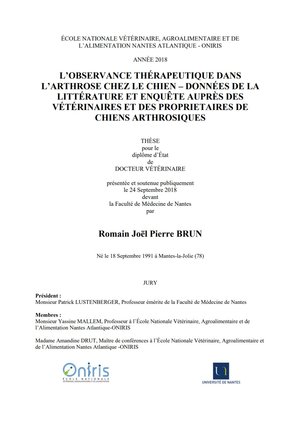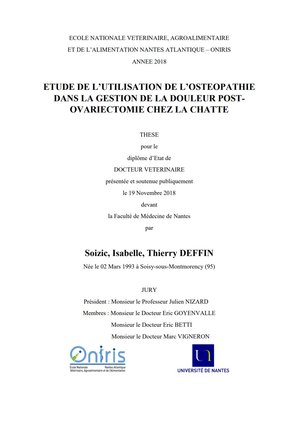Évaluation : douleurs chroniques observance ostéopathie
DOULEUR CHEZ LES CHIENS ET CHATS
1/ Creation and validation of the Italian version of the Glasgow Composite Measure Pain Scale-Short Form (ICMPS-SF)
Giorgia Della Rocca, Rodolfo Colpo, Jacqueline Reid, Alessandra Di Salvo and E. Marian Scott
Vet. Ital., 2018, vol. 53, n° 3, p. 251-260
Résumé :
Objective To validate the Italian translation of the Glasgow Composite Measure Pain Scale – Short Form (ICMPS-SF) in order to assess acute pain in dogs. The original English-version of the scale (the Glasgow Composite Measure Pain Scale – Short Form – CMPS-SF) was translated into Italian according to a standard protocol to ensure linguistic and cultural validity. Nine Italian veterinary surgeons then recorded pain scores in dogs undergoing orthopaedic or soft tissue surgery using the ICMPS-SF at 2, 6, and 24 hours post-extubation. Construct validity was demonstrated using hypothesis testing. A total of 95 dogs were recruited into the study. Thirty-seven dogs underwent orthopaedic procedures and 58 dogs underwent soft tissue procedures. Twenty-three, 45, and 27 procedures were classified as mild, moderate, and severe, respectively. Statistically significant differences in the median pain scores were demonstrated between orthopaedic and soft tissue cases as well as among mild, moderate, and severe cases. Median pain scores decreased with time and changes were statistically significant. The ICMPS-SF demonstrated construct validity similar to the original English-language scale, resulting in a valid and reliable instrument for the assessment of acute pain in dogs by Italian veterinarians.
2/ Qualitative study of owner perceptions of chronic pain in their dogs
Kelly N. Davis, Peter W. Hellyer, Eloise C. J. Carr RN, Jean E. Wallace, Lori R. Kogan
JAVMA, 2019, Vol. 254, No. 1, Pages 88-92
Résumé :
OBJECTIVE To understand the experiences of owners of dogs with chronic pain and explore owner perceptions of their pets’ pain. DESIGN Observational study. SAMPLE 10 owners of dogs with chronic pain. PROCEDURES Owners were interviewed by means of a semistructured and conversational technique. Interviews were then transcribed and analyzed with standard qualitative methodology to code for major themes. RESULTS Major themes that were identified included changes in owner schedule, effects on owner relationships, and necessary resources when owning a pet with chronic pain. Owners discussed their perceptions of their pets’ pain, and several participants referred to empathizing with their pet owing to their own experiences with pain. Owners also suggested ways that veterinarians can support them during the experience of owning a dog with chronic pain. CONCLUSIONS AND CLINICAL RELEVANCE By understanding the impact of chronic pain on dog owners and appreciating how owners perceive pain in their pets, veterinarians may be able to provide better care for patients and clients.
BRUN, Romain, thèse Oniris, 2018, cote : N-2018-040
Résumé :
Maladie chronique dégénérative et évolutive, l’arthrose fait encore aujourd’hui l’objet de protocoles thérapeutiques variés, mais toujours multimodaux. Aucun espoir de guérison n’est à l’heure actuelle permis, seulement une gestion quotidienne des crises aiguës de douleurs, une amélioration de l’état clinique de l’animal et un ralentissement de l’évolution inexorable de la maladie. Tous ces éléments semblent venir compliquer l’observance thérapeutique : le diagnostic et la prescription ne sont pas suffisant à eux seuls pour une prise en charge correcte de l’animal arthrosique. À la lumière de la définition actuelle de la notion d’observance, cette thèse présente les déterminants de l’observance thérapeutique dans l’arthrose canine, encore peu connus à ce jour, en lien avec les particularités de cette maladie et de sa prise en charge. L’objet de cette thèse est de mener une étude, par le biais de questionnaires, auprès des vétérinaires et propriétaires de chiens arthrosiques, pour faire un état des lieux de l’observance thérapeutique dans l’arthrose canine. Il a été estimé un taux d’observance à 56.9% chez les propriétaires de chiens arthrosiques. En parallèle, une demande très forte de leur part en matière d’informations et d’accompagnement a été notée, et ne semble pas toujours satisfaite. Des pistes d’améliorations ont alors été formulées en croisant ces résultats aux données adaptées de la littérature existant en médecine humaine et en médecine vétérinaire.

4/ Etude de l’utilisation de l’ostéopathie dans la gestion de la douleur post-ovariectomie chez la chatte
DEFFIN, Soizic, thèse Oniris, 2018, cote : N-2018-099
Résumé :
La prise en charge de la douleur est une problématique d’actualité dans le monde vétérinaire. Des systèmes d’évaluation de la douleur animale et de nombreux outils thérapeutiques se sont développés au cours des dernières décennies. Cependant, bien que la pharmacopée disponible en médecine vétérinaire soit vaste et permette une bonne analgésie, les demandes des praticiens vétérinaires et des propriétaires d’animaux continuent d’évoluer.
Les molécules utilisées en analgésie vétérinaire présentent effectivement des effets secondaires non négligeables, pouvant justifier une réflexion sur le rapport bénéfice/risque de la mise en place d’un traitement. Différentes médecines complémentaires ont par ailleurs prouvé leur efficacité dans la prise en charge de douleurs aigües (acupuncture) ou chroniques (physiothérapie entre autres) dans plusieurs études. L’objectif de ce travail expérimental était d’évaluer l’utilisation de l’ostéopathie dans la prise en charge de la douleur postopératoire lors d’ovariectomie chez la chatte en comparaison avec la Buprénorphine et l’absence d’analgésie. Les scores de douleur postopératoires ont été suivis pendant 6 jours après l’intervention chirurgicale.
Aucune différence significative n’a pu être mise en évidence entre le groupe Buprénorphine et le groupe Ostéopathie, ni entre le groupe sans analgésie et le groupe Ostéopathie. Une différence significative a été obtenue entre le groupe Buprénorphine et le groupe sans analgésie à 12h post-opératoire, les scores douleurs étant légèrement plus élevés pour le groupe sans analgésie. L’ostéopathie pourrait donc être une méthode intéressante dans la prise en charge de la douleur post-opératoire de pallier I et II (faible à modéré) chez le Chat.
Accessible à http://kentika.oniris-nantes.fr/ListRecordVisio.htm?idlist=80&record=19316647124911348299

